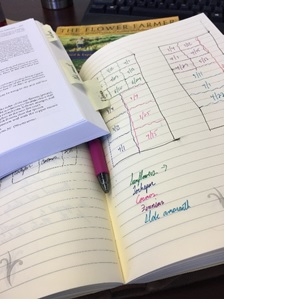Planning Your Annual Cut Flower Garden
Being a part of this thing we call “life”, I was unable to get an early start on preparing our cut flower garden this year. Between work, holidays, kids, dogs, rain and everything else, our last frost date (it's February 15th, by the way, here in my zone 10b, Sunset zone 19) completely caught me by surprise. So, this year, I'm going to try direct seeding everything. So, the first thing to figure out is what to plant and when.
This year we've decided on the flowers listed below. These are all varieties you can buy at your local big box store (or large on-line retailer for the gomphrena).
Sweet Peas – Lathyrus odoratus
Sunflowers - Helianthus
Larkspur - Delphinium
Cosmos – Cosmos bipinnatus
Zinnia – Zinnia elegans
Globe Amaranth – Gomphrena globosa
I'm going to keep it simple this year and grow popular flower types. As you can see from the picture, I'll be planting into two beds. Each bed is 4 feet by 8 feet and about 10 inches high. That will give me 64 square feet of growing space, and I should be able to get quite a few stems from this.
In planning the cut flower garden, one of the most important things to do is to find where south is in relation to your planting bed. The reason being, you do not want larger plants, or vines you're trellising, to block the sun from the plants behind them. Larger plants should be on the north side of your planting space. In my case, both my planting beds run east to west and, looking at the picture, south is to the left. Therefore, I'm going to plant my sweet peas, which I will be trellising on the right side of the right bed, which will put them on the north side of the garden.
After figuring out where the large plants will go, I break up the rest of the space into larger blocks and assign one flower type to each of those spots. In doing so, I end up with a block that is at least 2 feet by 4 feet. Since most flowers can be spaced 6-9 inches apart, an 8 square foot space can get in excess of 30 plants in place. That's a lot of flowers! Planting in blocks rather than rows (or “here and there”) can also help with fertilizing, watering and supporting as like type flowers are grouped close together. Make these sections as big or as small as you desire. Heck, if you have memories of your grandmother's Cosmos in summer, plant two beds full of those!
At this point, you have a couple of choices. You can put out all your seeds all at once or you can sow some sections every 2-3 weeks in order to keep the blooms going as long as possible. If you're going to do it all in one swoop, then at this point just get out there and start sowing. If you would like to try and time your blooms to have a little each week throughout the summer, then succession planting is for you.
In order to accomplish this, there is only one more step. For each of the blocks of plants you created, separate each one into three sections. You're first sowing will be in 1 of those sections. Three weeks later, sow the second section. Three weeks after that, sow the 3rd section. At this point, your first section should have seedlings well on their way. When that 1st section has finally given up for the season, the other two sections should have a few more weeks of blooms. However, if this seems daunting, please DO NOT feel overwhelmed and throw up your hands. Sowing all your seeds at the same time will still provide you with many wonderful blooms for the season.
Lastly, a note on planting directly from seed. There are certain varieties where planting seeds directly into the garden is not recommended, as you don't get as good germination rates as you would starting seeds indoors and then planting the seedlings out after they've started. Gomphrena is an example of this type. I went ahead and planted them anyway in order to see what happens. I have this habit of wanting to see things for myself. And, my poor scheduling skills this year have given me a great opportunity to test this out.
Throughout the summer, I'll post updates on this particular section of my garden, along with any hints or tips I happen to discover.
Now get out there and plant something.
